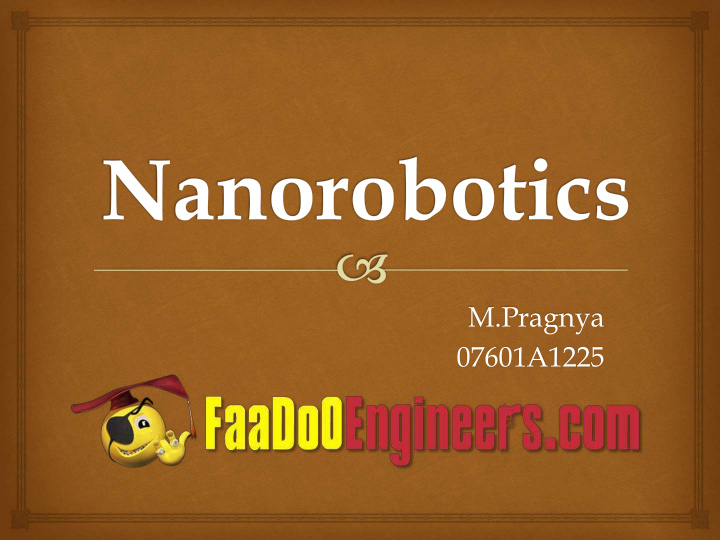



M.Pragnya 07601A1225
INTRODUCTION What is Nanorobotics Nanotechnology Aim of presentation Functionalities Nanometer Nanorobot Macro and nano-scale robots Nano robotics Bibliography
WHAT IS NANOROBOTICS: A technology with the advancement in nanotechnology. Creating- automatic machines, respondent devices and robots at the atomic scale of 10-9 nanometers. Used in most complex engineering & designing nanorobots. Constructed- ranging from 0.1 to 10 micrometers. 99% human like non biological robot. Emerging applications- medicine and technology.
NANOTECHNOLOGY Nanometer - billionth of a meter, 1/80,000 diameter of a human hair, or 10 times the diameter of a hydrogen atom. Size- measure, manipulate, and assemble matter on a scale of 1-100nm. The engineering of molecular products needs to be carried out by robotic devices, which have been termed nanorobots.
AIM OF PRESENTATION: Focuses -state of the art -its applications -essential properties -dynamical laws Reviewing- nano-scale robotic. -which are usually used in nanorobotics
ITS FUNCTIONALITIES: Swarm Intelligence – decentralization and distributive intelligence Cooperative behavior – emergent and evolutionary behavior Self assembly and replication – assemblage at nano scale and ‘nano maintenance’ Nano Information processing and programmability – for programming and controlling nanorobots (autonomous nanorobots) Nano to macro world interface architecture – an architecture enabling instant access to the nanorobots and its control and maintenance
BIO-NANOROBOTICS
Nature’s Nanorobotic Devices Protein based molecular machines ATP Synthase
The Kinesin, Myosin, Dynein and Flagella Molecular Motors
Nature’s Nanorobotic Devices DNA based molecular machines Inorganic (chemical) Molecular machines
Design and Control DESIGN
Control Internal control mechanisms Active and Passive External Control Mechanism Hybrid control mechanisms
Conclusion Dynamics and properties Bio nanorobotic systems Developing a complete database
BIBILIOGRAPHY Drexler Eric. K. 1992. Nanosystems : Molecular Machinery Manufacturing and Computation: John Wiley & Sons Block SM. 1998. Kinesin, What Gives? Cell 93: 5-8 Hackney DD. 1996, The 4 motors Annu Rev Physiol 58 : 731-50 Kull FJ, Sablin EP, Lau R, Fletterick RJ, Vale RD. 1996. kinesin motor domain reveals a structural similarity to myosin. Nature 380 : 550-5 . Blocker A, Severin FF, Burkhardt JK, Bingham JB, Yu H, et al. 1997. Molecular requirements for bi-directional movement of phagosomes along microtubules. J Cell Biol 137: 113-29
Recommend
More recommend